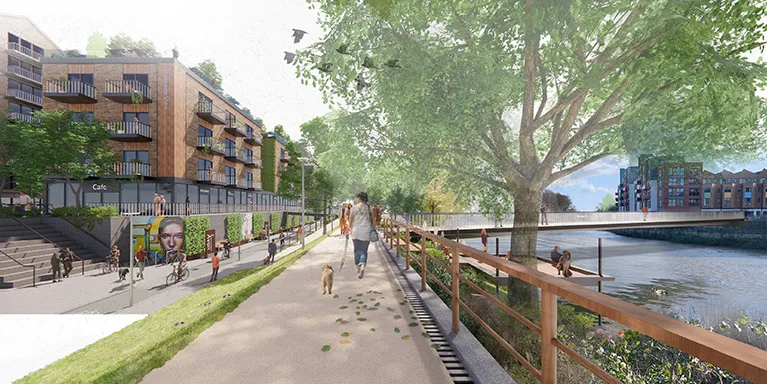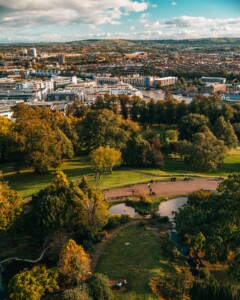Putting Work Futures in Their Place on a Bristol Industrial Estate

Share this
The phrase ‘future of work’ likely elicits a mental picture punctuated by the presence of robots and the invisible authority of algorithmic management. It is no surprise that this sleek, high-tech vision of the future garners a range of emotional responses, from excitement to fear.
The excitement may come from an overly optimistic expectation of heightened efficiency, where organisations deploy a robot workforce devoid of human limitations or error. The positive implications of technological replacement are often anticipated most by those who will harness it to their benefit.
It is those workers who perform tasks that are apparently easily automated that are intuitively understood by the existing academic research on the topic as most fearful about this future of work. Coincidentally it is these workers who are often neglected in discussions about the future of work amongst academics, journalists and policymakers, who tend to foreground the stories and experiences of other graduates or professionals involved in digital roles in the knowledge economy.
Having cultivated a working environment associated with high-tech creative and digital industries, Bristol has been characterised by the Institute for the Future of Work as a ‘Good Work Winner’, with a higher-than-average provision of good work which ‘builds resilience against social, economic and health shocks’. However, this comfortable accommodation to the changing world of work is far from a universal phenomenon. This highlights the need for approaches which allow for and recognise a more granular and contentious experience of transitions in working life. A place-based approach allows us to consider more closely the potential political consequences and challenges of everyday futures of work as they unfold in communities up and down the country.
It was this ethos that inspired our study of changes in working life on St Philip’s Marsh Industrial Estate in Central Bristol. In January 2022, while employed at the University of Bristol, we began working together on a ‘Bristol Model’ project funded by Research England and the Office for Students, entitled ‘Worker Perceptions of the Future of Work in Bristol’. We have since published a report, The Bristol Project: Talking about work on a city-centre industrial estate, on our findings with the Institute for the Future of Work.
St Philip’s Marsh represented an interesting case study because of its status as a crucible for many of the shifts affecting the city. On the surface of things, Bristol does not fit neatly into the geographical, political, and cultural classification of the so-called ‘left behind’ spaces of industrial change commonly perceived as the target of the ‘Levelling Up’ agenda. However, pockets like St Philip’s Marsh more closely resemble other areas of the country where shifts like industrial rebalancing, reshoring and the green transition present both risks and opportunities.
Moreover, its history is marked by change, transition and contested futures. In the mid-twentieth century, housing was demolished to make way for the industrial infrastructure of today. This consists of large warehouses for waste management, cement mixing companies, oil vendors and the like. Over the decades, many diverse visions of the future of the Marsh have been put forward and debated.
Having conducted more than 20 interviews with people who work and trade on the Marsh, we found that highly local prosaic and place-specific factors tangibly shape how workers view the future of their work and the firms or industries that employ them. The types of work performed on the Marsh are diverse. However, workers were aware of the place-based and material requirements of their work. For instance, one interviewee explained, ‘You have to have somewhere in this area where people can work. And not everybody can sit and work in an office. Not everybody is good at that type of thing. You know, IT and selling insurance and banking and that type of thing. And you need hands-on people. You need somebody who can mend a lorry.’
Trading estates are an unsung but common part of the country’s social, geographic and economic landscape – ecologies of industry and innovation that rarely get thought of as such. They are home to concentrations of small and medium-sized enterprises that play a vital role in the skilled trades, supply chains and services that underpin and power the local ‘everyday economy’, as well as regional industrial clusters. The type of work performed on St Philip’s Marsh – being largely of a routine character – is often seen as most at risk to automation, an issue of vital concern to those interrogating futures of work.
It is undeniably true that technology plays a major role in shaping work. However, our foray into St Philip’s Marsh revealed a far more complex spectrum of futures making themselves tangible to workers in the here and now. In fact, the relatively slow progress of technological replacement meant that it barely registered as a risk amongst workers there. Routine workers involved in the sorting of the city’s recycling, the mixing of cement and the receipt of fruit and vegetable goods, for instance, face far greater uncertainty about their employment owing to proposed development plans than they do due to technology. Processes of local urban transformation, viewed as regeneration, often overlook the drastic and rapid impacts they can have on the lives of workers.
As well as being home to many routine jobs, industrial estates in many cities and towns have come to provide cheap, plentiful and adaptable space for entrepreneurs, creatives and artisan producers, as well as land ripe for acquisition by housebuilders and new mixed-use developments. These trends present a mixed picture for industrial estates.
On the one hand, we see the revitalisation of estates in line with new craft industries that in some cases, such as brewing, rediscover and reinvent trades that return to the foundation of these local industrial areas. These also contribute to new forms of employment that, despite superficial differences with many of the trades and professions associated with industrial estates, contain plenty of scope for shared issues and visions of good work.
On the other hand, regeneration can be bound up with perceived gentrification, even where planning initiatives seek to meet societal needs for housing for instance. Measures to bring about a greener environment, especially where a city-centre location means that the estate is seen as a source of pollution or other environmental concerns, can be a source of particular tension. These threaten to displace workers and businesses that have had little say in the matter and find themselves, their work and their industries at risk.
St Philip’s Marsh exhibits many of these tendencies. Today, the area is subject to major transformation as part of the Temple Quarter regeneration plans. The 2021 report by Bristol City Council and partners, Temple Quarter & St Philip’s Marsh: A vision for the future, explained that investment would ‘unlock the potential to redevelop St Philip’s Marsh creating new, sustainable neighbourhoods where housing sits alongside business and workspaces’. More specifically, St Philip’s is imagined as a place for ‘Creative and High Tech Innovation’ nurturing a ‘creative and knowledge-based economy of small and medium-sized businesses’.
Although plans for St Philip’s Marsh are longer term, smaller and shorter-term shifts are already apparent, consistent with changes in other industrial estates across the UK. Established enterprises and industries are being augmented or replaced by new artisan and craft businesses like breweries, coffee roasteries, workshops for creative arts and event spaces. But, as St Philip’s is set to go through yet another reimagining, it is vital to query whose vision is being implemented and whose vision may be being abandoned.
To do this we must focus our attention on a broader array of anxieties and tensions that occupy the space between the workplace and the wider ‘place’ within which work is grounded and granted its context. While residents may be consulted in changes and transitions where they live, workers are less often asked for their input on transformations affecting the places where they will likely spend much of their waking and working lives.
It is important to see work and workers constituting communities, and workers themselves as citizens within a set of civic relationships, to grant them voice over the changes that are afoot in cities and towns around green transitions, shifts in urban land use and other factors. This means that new channels and infrastructures of representation are needed to ensure the voices of working people are incorporated when developing futures of place which in turn have implications for futures of work.
Workers are subject to multiple, interacting shocks which transform conditions for work. These can drive adjustment costs for workers, which may be material or social. But workers do not always have clearly defined mechanisms to shape, contest or negotiate these changes. While greater worker voice at the level of the firm will inevitably be necessary to contest and coordinate the future of work as it is felt in the workplace, our work suggests it is equally important to ensure the needs of workers from across the economy are represented in broader processes of economic redevelopment and place-based transformation.
In Bristol as elsewhere, working people must be given as much a stake in the development of towns and cities as residents or business owners. It is only in doing so that planning initiatives and transition schemes can secure the full and broad local consent needed to be a success.
Image credit: Bristol Temple Quarter

M Winter is a post-doctoral researcher in the Department of Business Administration at Tallinn University of Technology in Estonia. She is also a research fellow at the Institute for the Future of Work in London, UK.
Frederick Harry Pitts is Senior Lecturer in Politics and Director of Business Engagement and Innovation in the Department of Humanities and Social Sciences at University of Exeter’s Cornwall Campus. He is a Co-Investigator of the ESRC Centre for Sociodigital Futures.
This article appears in Bristol 650: Essays on the Future of Bristol, a book bringing together essays from over 30 contributors, addressing some of the challenges the city faces and sharing ideas about how we might meet them. From dealing with the past, the future of social care, culture and housing to building a city of aspiration, the book looks to promote learning about the future of Bristol and encourage new ideas to come forward.
Free copies of Bristol 650: Essays on the Future of Bristol will be available at selected Festival of the Future City events in October 2023, or you can find articles featured in the book at bristolideas.co.uk/bristol650book.



